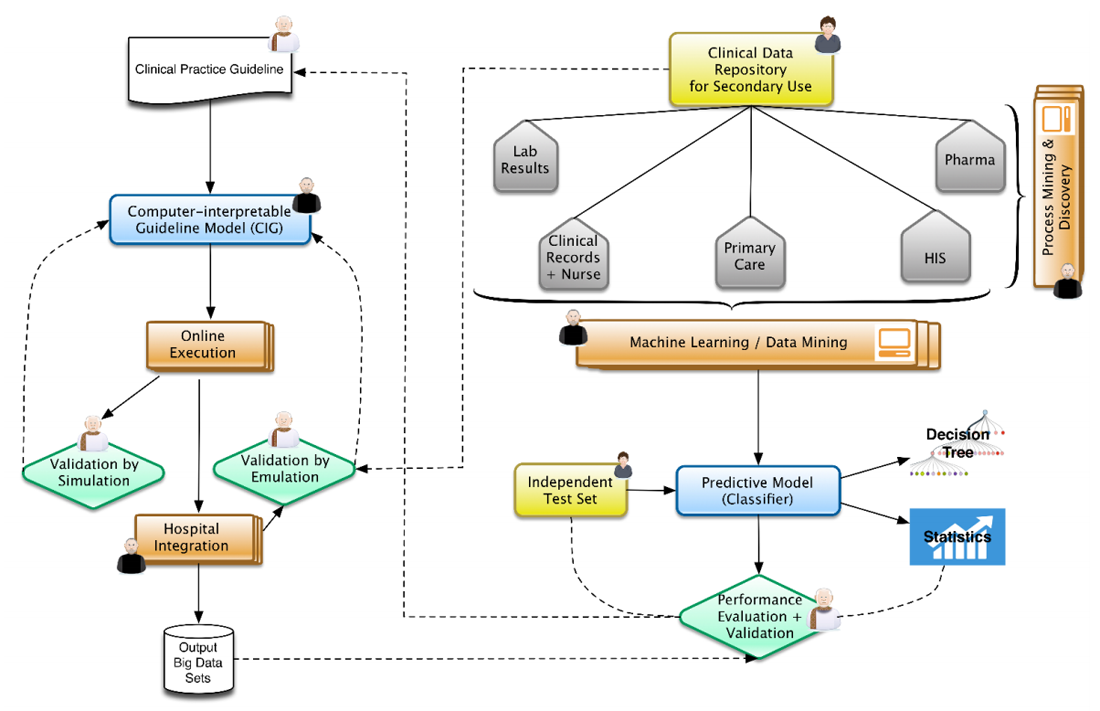Difference between revisions of "Template:Article of the week"
Shawndouglas (talk | contribs) (Updated article of the week text.) |
Shawndouglas (talk | contribs) (Updated article of the week text.) |
||
| Line 1: | Line 1: | ||
<div style="float: left; margin: 0.5em 0.9em 0.4em 0em;">[[File:Fig1 | <div style="float: left; margin: 0.5em 0.9em 0.4em 0em;">[[File:Fig1 González-FerrerIJIMAI2018 4-7.png|240px]]</div> | ||
'''"[[Journal: | '''"[[Journal:Generating big data sets from knowledge-based decision support systems to pursue value-based healthcare|Generating big data sets from knowledge-based decision support systems to pursue value-based healthcare]]"''' | ||
Talking about big data in healthcare we usually refer to how to use data collected from current [[electronic medical record]]s, either structured or unstructured, to answer clinically relevant questions. This operation is typically carried out by means of analytics tools (e.g., machine learning) or by extracting relevant data from patient summaries through natural language processing techniques. From other perspectives of research in [[medical informatics]], powerful initiatives have emerged to help physicians make decisions, in both diagnostics and therapeutics, built from existing medical evidence (i.e., knowledge-based [[Clinical decision support system|decision support systems]]). Many of the problems these tools have shown, when used in real clinical settings, are related to their implementation and deployment, more than failing in their support; however, technology is slowly overcoming interoperability and integration issues. Beyond the point-of-care decision support these tools can provide, the data generated when using them, even in controlled trials, could be used to further analyze facts that are traditionally ignored in the current clinical practice. In this paper, we reflect on the technologies available to make the leap and how they could help drive healthcare organizations shifting to a value-based healthcare philosophy. ('''[[Journal:Generating big data sets from knowledge-based decision support systems to pursue value-based healthcare|Full article...]]''')<br /> | |||
<br /> | <br /> | ||
''Recently featured'': | ''Recently featured'': | ||
: ▪ [[Journal:Characterizing and managing missing structured data in electronic health records: Data analysis|Characterizing and managing missing structured data in electronic health records: Data analysis]] | |||
: ▪ [[Journal:Closha: Bioinformatics workflow system for the analysis of massive sequencing data|Closha: Bioinformatics workflow system for the analysis of massive sequencing data]] | : ▪ [[Journal:Closha: Bioinformatics workflow system for the analysis of massive sequencing data|Closha: Bioinformatics workflow system for the analysis of massive sequencing data]] | ||
: ▪ [[Journal:Big data management for cloud-enabled geological information services|Big data management for cloud-enabled geological information services]] | : ▪ [[Journal:Big data management for cloud-enabled geological information services|Big data management for cloud-enabled geological information services]] | ||
Revision as of 14:35, 1 May 2018
Talking about big data in healthcare we usually refer to how to use data collected from current electronic medical records, either structured or unstructured, to answer clinically relevant questions. This operation is typically carried out by means of analytics tools (e.g., machine learning) or by extracting relevant data from patient summaries through natural language processing techniques. From other perspectives of research in medical informatics, powerful initiatives have emerged to help physicians make decisions, in both diagnostics and therapeutics, built from existing medical evidence (i.e., knowledge-based decision support systems). Many of the problems these tools have shown, when used in real clinical settings, are related to their implementation and deployment, more than failing in their support; however, technology is slowly overcoming interoperability and integration issues. Beyond the point-of-care decision support these tools can provide, the data generated when using them, even in controlled trials, could be used to further analyze facts that are traditionally ignored in the current clinical practice. In this paper, we reflect on the technologies available to make the leap and how they could help drive healthcare organizations shifting to a value-based healthcare philosophy. (Full article...)
Recently featured:










